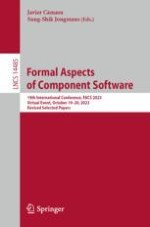2024 | Buch
Formal Aspects of Component Software
19th International Conference, FACS 2023, Virtual Event, October 19-20, 2023, Revised Selected Papers
herausgegeben von: Javier Cámara, Sung-Shik Jongmans
Verlag: Springer Nature Switzerland
Buchreihe : Lecture Notes in Computer Science
